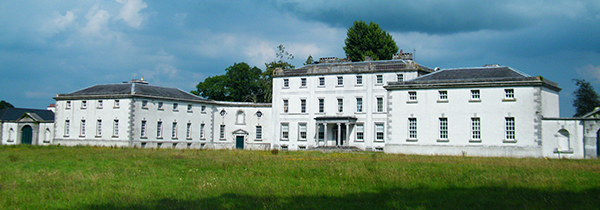Strokestown Park, County Roscommon
Published in Gems of Architecture, Issue 4 (July/August 2016), Volume 24By Damian Murphy
The history of the Strokestown Park estate dates back to the sixteenth century and a castle destroyed in 1552 by Mac Diarmada. The present estate, however, began to take shape in the seventeenth century when land previously owned by the O’Conor Roe was acquired by the Mahon family. Captain Nicholas Mahon (d. 1680) set about building a house, which was completed in 1696, after his death. Traces survive at basement level, where a panelled still room, once a principal reception room, retains a rosette-detailed Jacobean chimney-piece, an egg-and-dart-detailed plasterwork overmantle decorated with fruits and shells, and a compartmentalised ceiling with dentilated moulded plasterwork cornices. Some earlier remains of the castle are also found in the basement, where sections of the walls measure almost 3m deep.

Above: A central block of seven bays and three storeys links to two-storey wings via curved quadrant ‘sweeps’. (Irish Heritage Trust)
Strokestown Park House took on its present form in the early eighteenth century, when it was almost entirely rebuilt by Thomas Mahon (1701–82), possibly when he married the Hon. Jane Crosbie in 1735. The design in the fashionable neo-Palladian style has been attributed to Richard Castle (d. 1751). A central block of seven bays and three storeys links to two-storey wings via curved quadrant ‘sweeps’, the overall plan reminiscent of the contemporary French Park House (1729), demolished in the 1970s. The arrangement of central pedimented doorcases, empty niches and oculi on the ‘sweeps’ is a hallmark of Castle’s work.
Succeeding generations of the Mahons adapted the house according to contemporary tastes. Maurice Mahon (1738–1819), elevated to the peerage as Baron Hartland in 1800, refaced the central block and introduced a central portico carried on chiselled limestone Ionic columns. Full-height panelled pilasters support a balustraded parapet with central die [panel]. The architect for the improvements was John Lynn (d. 1864) of Sligo. Maurice Mahon also added the eye-catching tripartite gate that presents the Strokestown Park estate to the town, as well as laying out the town itself.
In 1845 the estate passed to Major Denis Mahon (1787–1847), whose brief tenure came to a gruesome end when he was assassinated during the Great Famine. Strokestown Park House remained the home of the Pakenham Mahon family until 1979, when the house, essentially unchanged since the early nineteenth century, along with what remained of the estate, was sold to Westward Garage, a local company. Almost all of the original furniture remained, together with the estate office papers, an internationally important archive that has been used to explain the significance of the Great Famine in Ireland. The kitchens and stables in the wings survive almost intact, and the galleried kitchen is probably the finest example of its type in Ireland. The stables, now housing the Irish National Famine Museum, boast beautiful groin-vaulted ceilings resting on an elegant colonnade of chiselled limestone Tuscan pillars. Their elegance earned them the nickname ‘The Equine Cathedral’.
Strokestown Park House opened to the public in 1987 and its conservation and restoration are ongoing. The restored walled gardens were opened in 1997. The Irish Heritage Trust took over the operation of the estate in 2015, with assistance from Westward.
Damian Murphy is an Architectural Heritage Officer with the National Inventory of Architectural Heritage (NIAH). Series based on the NIAH’s ‘building of the month’, www.buildingsofireland.com.
















